Aluminum Free Deodorant focuses on odor control without interfering with the body’s natural sweating process. Advances in natural chemistry have allowed these products to neutralize odor-causing bacteria without using aluminum salts.
Initially, you’ll likely go through an adjustment period of a few weeks when switching to an aluminum-free deodorant. This is because your body will need to get used to sweating and smelling naturally again.
The vast majority of deodorants on the market are formulated with chemicals that have been linked to various health issues, from cancer and infertility to migraines and Alzheimer’s. But these chemicals aren’t the only problem. Many of them are also greasy, which means they can leave white marks and stain light-colored clothes. Luckily, advances in natural chemistry have made it possible to create products that effectively neutralize body odor without relying on aluminum. These natural products are gentler for the skin and more in tune with a holistic lifestyle.
The aluminum used in antiperspirants plugs up your sweat ducts, which makes it harder for you to sweat. When you switch to aluminum free deodorant, you can expect a brief ‘detox’ period as your sweat glands re-acclimate to perspiration. During this time, you may notice that you’re sweating more or that your sweat has a different odor. But you’ll likely find that, after a few weeks, your sweat and odor will have returned to normal.
Most deodorants are packaged in plastic, a material that is not good for you or the environment. Fortunately, there are now a variety of brands that offer aluminum free deodorant in recyclable packaging. These are a great option for anyone looking to cut down on their plastic use or reduce their environmental footprint.
Unlike some other deodorant brands, PurelyGreat uses natural ingredients, like coconut oil, baking soda and vegetable waxes to make a safe, non-greasy alternative that actually works. Our ingredients are never tested on animals, and we refuse to buy any that are, which is why we are proud to be cruelty free.
It’s easy to understand why more and more people are ditching their old antiperspirants and trying out aluminum free deodorant. The toxins in these mass-produced antiperspirants aren’t just bad for your health; they can even damage your clothing and leave behind white marks on your underarms. But, when you make the switch to a natural, aluminum free deodorant like ours, you’ll be glad you did. Our products are easy to apply and keep you fresh all day long.
Many aluminum free deodorants are made of natural ingredients, which is great news for your skin. They usually contain a blend of baking soda, arrowroot and safe synthetics to absorb odor and inhibit bacteria. They may take a little time to get used to, especially if you’re switching from antiperspirant, which can leave behind white marks and staining on your clothing (that’s because the aluminum in it reacts with your sweat). Natural deodorants use a less harsh, gentler formula that works to reduce body odor instead of blocking it altogether.
Another benefit of aluminum free deodorant is that it’s free from other chemicals that have been linked to health issues, such as parabens, triclosan and propylene glycol. These chemicals are commonly found in antiperspirants and can be absorbed into your bloodstream. When you switch to an aluminum free deodorant, your underarms are exposed to fewer toxic ingredients that can have negative long-term health effects.
If you’re switching from an antiperspirant to a natural or aluminum-free deodorant, it’s important to make the transition at a cooler time of year (fall, winter or spring), when it’s less humid. It can take a few weeks for your body to adjust to not having an aluminum inhibitor stopping your perspiration, which is why it’s a good idea to choose a cooler season.
While you wait for your body to adjust, be sure to drink plenty of water and shower daily. This will help keep you hydrated and prevent any itching or irritation that can happen during this period. Also, be sure to apply your new deodorant under arms when they’re dry after showering—it’s not effective on damp skin.
When it comes to buying an aluminum-free deodorant, the most important thing is to find one that works for you and your unique body chemistry. Some products may need to be reapplied throughout the day, while others require just a swipe or two. You may even need to try several different brands to find the right one for you. Fortunately, there are plenty of options out there to try, including the brand Type: A, which is free from aluminum, but has been formulated with natural ingredients and safe synthetics to provide a long-lasting odor control.
Many aluminum-free deodorants still provide strong odor protection, but in a healthier way. Instead of blocking sweat like antiperspirants, they use ingredients such as baking soda or zinc oxide to neutralize odor-causing bacteria and help your body release moisture naturally. They’re often gentler and easier on the skin, too. Plus, some brands offer a spray or stick formula, which allows you to reapply throughout the day (try keeping a travel-size bottle in your bag).
The main reason people switch to aluminum free deodorant is because they’re concerned about their health. Many of the aluminum-containing deodorants and antiperspirants on the market also contain a variety of chemicals that have been linked to serious health issues, including breast cancer. If you’re breastfeeding or planning on becoming pregnant, it’s especially important to make the switch because whatever toxins are being absorbed by your body are being passed onto your developing baby.
Some brands have gone even further to make their products as clean and healthy as possible by ditching the aluminum altogether. Their products may still block sweat to some extent, but they do so with ingredients such as arrowroot powder, shea butter, coconut oil, and kaolin clay. They can also be scented with fragrances made from natural, plant-based oils such as lavender and chamomile.
These aluminum-free deodorants are also free of a host of other chemicals that you might want to avoid, such as propylene glycol, parabens, phthalates, and artificial fragrances. They’re also often packaged in recycled or biodegradable plastic, which is better for the environment than the hard-to-recycle aluminum found in most antiperspirants.
If you’ve been using aluminum-based deodorants for a long time, it can take a while to get used to an aluminum-free alternative. But once you do, you’ll find that you have more confidence in your ability to stay smelling fresh all day. Plus, you won’t have to worry about those unsightly pit stains that can appear on light shirts—a common problem for people who are used to traditional antiperspirants. And finally, you’ll be saving money on those overpriced deodorant sticks that you end up having to replace often because they don’t work as well as they should.
This aluminum-free deodorant is the perfect solution for anyone looking to reduce their exposure to potentially harmful chemicals in everyday hygiene products. Unlike traditional antiperspirants, which use aluminum to block sweat ducts and prevent you from perspiring, natural deodorants absorb excess moisture and eliminate odor by killing the bacteria that causes it. This deodorant does not contain any parabens, propylene glycol, talc, or sulfates and is vegan-friendly and cruelty-free.
Moreover, it uses an organic alcohol base to help the deodorant stay on your skin longer, eliminating the need for constant reapplication and ensuring that you can always get fresh and ready for whatever comes your way. You can also rest easy knowing that the ingredients in this deodorant have been carefully selected to be non-irritating and safe for all skin types, including sensitive.
As a result of recent concerns about the links between aluminum and breast cancer, Alzheimer’s disease, and other health issues, more consumers have begun to seek out aluminum-free deodorants and other personal care products. As a result, these products are increasingly found in major retailers alongside conventional counterparts.
Although rumors have since been proven false, the concern about these potential risks continues to inspire consumers to seek out alternatives that do not contain aluminum. Fortunately, advances in natural chemistry have made it possible to effectively neutralize odors without the use of aluminum, with products containing ingredients like baking soda, activated charcoal, arrowroot powder, and shea butter that absorb moisture and kill odor-causing bacteria.
Additionally, many of these products are free of other irritating ingredients like sulfates, phthalates, propylene glycol, and estrogen-mimicking fragrances, and are made with only natural, skin-friendly oils and raw shea butter. As a result, choosing a natural deodorant is not only better for your body and skin, but it’s also better for the environment.
However, it’s important to note that it can take a few weeks for your body to adjust from using aluminum-containing antiperspirant to an aluminum free deodorant. During this time, you may notice that you sweat more than usual and have a more persistent odor, but your body will eventually return to its normal functioning without the use of chemicals. Until then, be sure to continue using your new deodorant, and remember to apply it daily to clean, dry armpits in the morning after you shower.

